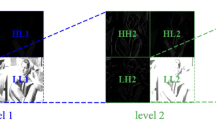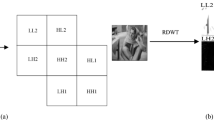Abstract
The detection of watermarks can be achieved by statistical approaches. How to select robust modeling object, appropriate statistical model, and decision rules is one of the major issues in statistical image watermark detection. In this paper, we propose a new image watermark detector in robust fast radial harmonic Fourier moments (FRHFMs) magnitudes domain, wherein the Beta-exponential distribution model and locally most powerful (LMP) decision rule are used. We first investigate the statistical modeling of the robust FRHFMs magnitudes by the Beta-exponential distribution. It is shown that the Beta-exponential distribution model fits the empirical data more accurately than the formerly employed statistical distributions, such as the Cauchy, Weibull, BKF, and Exponential, do. Motivated by the statistical modeling results, we design a blind image watermark detector in FRHFMs magnitudes domain by using Beta-exponential distribution and LMP test. Also, we utilize the Beta-exponential model to derive the closed-form expressions for the watermark detector. We provide comparative experimental results to alternative approaches to demonstrate the advantages of the proposed image watermark detector.















Similar content being viewed by others
Data availability
Enquiries about data availability should be directed to the authors.
References
Amirmazlaghani M (2017) A novel statistical detector for contourlet domain image watermarking using 2D-GARCH model. In: International conference on image analysis & processing, pp 547–557
Alghoniemy M, Tewfik AH (2000) Image watermarking by moment invariants. In: Proceeding of the 2000 international conference on image processing, Vancouver, BC, Canada, pp 73–76
Amirmazlaghani M (2019) Heteroscedastic watermark detector in the contourlet domain. IET Comput vis 13(3):249–260
Amirmazlaghani M, Rezghi M, Amindavar H (2015) A novel robust scaling image watermarking scheme based on Gaussian mixture model. Expert Syst Appl 42(4):1960–1971
Amini M, Ahmad MO, Swamy MNS (2017a) A new locally optimum watermark detection using vector-based hidden Markov model in wavelet domain. Signal Process 137:213–222
Amirmazlaghani M (2016) Additive watermark detection in the wavelet domain using 2D-GARCH model. Inf Sci 370–371:1–17
Amini M, Sadreazami H, Ahmad MO, Swamy MNS (2017b) Multichannel color image watermark detection utilizing vector-based hidden Markov model. In: Proceedings of the 2017b IEEE international symposium on circuits and systems, Baltimore, MD, USA, pp 1–4
Ahmaderaghi B, Kurugollu F, Rincon JMD, Bouridane A (2018) Blind image watermark detection algorithm based on discrete shearlet transform using statistical decision theory. IEEE Trans Comput Imaging 4(1):45–59
Amini M, Sadreazami H, Ahmad MO, Swamy MNS (2019) A channel-dependent statistical watermark detector for color images. IEEE Trans Multimed 21(1):65–73
Barazandeh M, Amirmazlaghani M (2016) A new statistical detector for additive image watermarking based on dual-tree complex wavelet transform. In: Proceeding of the 2016 2nd international conference of signal processing and intelligent systems. Tehran, Iran
Bhinder P, Singh K, Jindal N (2018) Image-adaptive watermarking using maximum likelihood decoder for medical images. Multimed Tools Appl 77(8):10303–10328
Bi HB, Liu Y, Wu MM, Ge YL (2016) NSCT domain additive watermark detection using RAO hypothesis test and Cauchy distribution. Math Probl Eng 2016:1–18
Dong L, Yan Q, Lv Y, Deng SY (2016) Full band watermarking in DCT domain with Weibull model. Multimed Tools Appl 76(2):1–18
Etemad S, Amirmazlaghani M (2017) A new multiplicative watermark detector in the contourlet domain using t location-scale distribution. Pattern Recogn 77:99–112
Etemad S, Amirmazlaghani M (2016) Additive watermark detector in contourlet domain using the t location-scale distribution. In: Proceeding of the 2016 2nd international conference of signal processing and intelligent systems. Tehran, Iran
Hosny KM, Darwish MM (2019) Resilient color image watermarking using accurate quaternion radial substituted Chebyshev moments. ACM Trans Multimed Comput Commun Appl 15(2):1–25
Hosny KM, Darwish MM, Fouda MM (2021) Robust color images watermarking using new fractional-order exponent moments. IEEE Access 9:47425–47435
Hosny KM, Darwish MM (2018) Robust color image watermarking using invariant quaternion Legendre-Fourier moments. Multimedia Tools Appl 77(19):24727–24750
Kumar S, Chhaparwal P, Zou G (2016) A robust unbiased dual to product estimator for population mean through modified maximum likelihood in simple random sampling. Cogent Math 3(1):1168070
Liu X, Han G, Wu J, Shao Z, Coatrieux G, Shu H (2017) Fractional Krawtchouk transform with an application to image watermarking. IEEE Trans Signal Process 65(7):1894–1908
Liu J (2018) An image watermarking algorithm based on energy scheme in the wavelet transform domain. In: Proceedings of the 2018 IEEE 3rd international conference on image, vision and computing, Chongqing, China, pp 668–672
Liu X, Wu Y, Zhang H, Wu J, Zhang L (2021) Quaternion discrete fractional Krawtchouk transform and its application in color image encryption and watermarking. Signal Process 189:108275
Liu Y, Zhang S, Yang J (2020) Color image watermark decoder by modeling quaternion polar harmonic transform with BKF distribution. Signal Process Image Commun 88:115946
Ma B, Chang L, Wang C, Li J, Wang X, Shi Y (2020) Robust image watermarking using invariant accurate polar harmonic Fourier moments and chaotic mapping. Signal Process 172:107544
Nadarajah S, Kotz S (2006) The beta exponential distribution. Reliab Eng Syst Saf 91(6):689–697
Oral E (2017) Modified maximum likelihood estimation in Poisson regression. Biom Biostat Int J 6(1):00154
Prabha K, Vaishnavi M, Sam I. Quaternion Hadamard transform and QR decomposition based robust color image watermarking. In: The 3rd international conference on trends in electronics and informatics (ICOEI), 23–25 April, 2019, Tirunelveli, India
Qu HJ, Peng YH (2008) Contourlet coefficient modeling with generalized Gaussian distribution and application. In: Proceedings of the international conference on audio, language and image processing, Shanghai, China, pp 531–535
Rabizadeh M, Amirmazlaghani M, Attari MA (2016) A new detector for contourlet domain multiplicative image watermarking using Bessel K form distribution. J vis Commun Image Represent 40:324–334
Sadreazami H, Ahmad MO, Swamy MNS (2015a) Optimum multiplicative watermark detector in contourlet domain using the normal inverse Gaussian distribution. Proceeding of the IEEE international symposium on circuits & Systems. Lisbon, Portugal, pp 1050–1053
Singh AK (2017) Improved hybrid algorithm for robust and imperceptible multiple watermarking using digital images. Multimed Tools Appl 76(6):8881–8900
Sedighi V, Fridrich J, Cogranne R (2015) Content-adaptive pentary steganography using the multivariate generalized Gaussian cover model. Media Watermark Secur Forensics 9409H:1–13
Sadreazami H, Ahmad MO, Swamy MNS (2015b) A robust multiplicative watermark detector for color images in sparse domain. IEEE Trans Circuits Syst II Express Briefs 62(12):1159–1163
Vaughan DC, Tiku ML (2000) Estimation and hypothesis testing for a nonnormal bivariate distribution with applications. Math Comput Model 32(1–2):53–67
Wang XY, Tian J, Tian JL, Niu PP, Yang HY (2021a) Statistical image watermarking using local RHFMs magnitudes and Beta exponential distribution. J vis Commun Image Represent 77:103123
Wang XY, Liu YN, Xu H, Wang AL, Yang HY (2016a) Blind optimum detector for robust image watermarking in nonsubsampled shearlet domain. Inf Sci 372:634–654
Wang XY, Zhang SY, Wena TT, Yang HY, Niu PP (2019) Coefficient difference based watermark detector in nonsubsampled contourlet transform domain. Inf Sci 503:274–290
Wang C, Hao Q, Ma B, Wu X, Li J (2021b) Octonion continuous orthogonal moments and their applications in color stereoscopic image reconstruction and zero-watermarking. Eng Appl Artif Intell 106:104450
Wang CP, Wang XY, Li YW, Xia ZQ, Zhang C (2018) Quaternion polar harmonic Fourier moments for color images. Inf Sci 450:141–156
Wang CP, Wang XY, Xia ZQ (2016b) Geometrically invariant image watermarking based on fast radial harmonic Fourier moments. Signal Process Image Commun 45:10–23
Xia Z, Wang X, Wang M, Unar S, Wang C, Liu Y (2019a) Geometrically invariant color medical image null-watermarking based on precise quaternion polar harmonic Fourier moments. IEEE Access 7:122544–122560
XAvailable: http://decsai.ugr.es/cvg/dbimagenes/index.php.
Xia Z, Wang X, Zhou W (2019b) Color medical image lossless watermarking using chaotic system and accurate quaternion polar harmonic transforms. Signal Process 157:108–118
Xiao B, Luo J, Bi X, Li W, Chen B (2020) Fractional discrete Tchebyshev moments and their applications in image encryption and watermarking. Inf Sci 516:545–559
Yamni M, Daoui A, Ogri O (2020) Fractional Charlier moments for image reconstruction and image watermarking. Signal Process 171:107509
Zhou X, Ma Y, Zhang Q, Mohammed MA, Damaševičius R (2021) A reversible watermarking system for medical color images: balancing capacity, imperceptibility, and robustness. Electronics 10:1024. https://doi.org/10.3390/electronics10091024
Zebbiche K, Khelifi F, Loukhaoukha K (2018) Robust additive watermarkig in the DTCWT domain based on perceptual masking. Multimed Tools Appl 77(16):21281–21304
Acknowledgements
This work was supported partially by the National Natural Science Foundation of China (Nos. 61472171 & 61701212), Scientific Research Project of Liaoning Provincial Education Department (No. LJKZ0985), and Natural Science Foundation of Liaoning Province (2019-ZD-0468).
Funding
The authors have not disclosed any funding.
Author information
Authors and Affiliations
Corresponding author
Ethics declarations
Ethical standard
All procedures performed in studies involving human participants were in accordance with the ethical standards of the institutional and/or national research committee and with the 1964 Helsinki Declaration and its later amendments or comparable ethical standards.
Conflict of interest
The authors declare that they have no conflict of interest.
Informed consent
Informed consent was obtained from all individual participants included in the study.
Additional information
Publisher's Note
Springer Nature remains neutral with regard to jurisdictional claims in published maps and institutional affiliations.
Appendix A: Variance and mean of log-likelihood ratio under hypotheses H 0 and H 1.
Appendix A: Variance and mean of log-likelihood ratio under hypotheses H 0 and H 1.
In this section, the likelihood ratio provided can be regarded to obey the Beta-exponential distribution conditioned on each of the H0 and H1 hypotheses. We can calculate the variance and mean under the two hypotheses, i.e., \(\sigma_{0}\), \(\sigma_{1}\), \(\mu_{0}\), \(\mu_{1}\). An expression for the mean \(\mu_{0}\) under the H0 hypothesis is derived by
Similarly, we also give the mean \(\mu_{1}\) of the log-likelihood ratio based on hypothesis \(H_{1} :{\text{y}} = {\text{x}}(1 + \lambda {\text{w}})\) by
where \(\omega_{i} = \left( {\frac{{\lambda \left( {x_{i} + \lambda x_{i} } \right)}}{2}} \right)\left( {\beta k - \tfrac{{(\alpha - 1) \cdot ke^{{ - k\left( {x_{i} + \lambda x_{i} } \right)}} }}{{1 - e^{{ - k\left( {x_{i} + \lambda x_{i} } \right)}} }}} \right),\) \(\upsilon_{i} = \left( { - \frac{{\lambda \left( {x_{i} - \lambda x_{i} } \right)}}{2}} \right)\left( {\beta k - \tfrac{{(\alpha - 1) \cdot ke^{{ - k\left( {x_{i} - \lambda x_{i} } \right)}} }}{{1 - e^{{ - k\left( {x_{i} - \lambda x_{i} } \right)}} }}} \right)\). The variance under hypothesis H0 is expressed by
The variance under hypothesis H1 is given by
Rights and permissions
About this article
Cite this article
Wang, Xy., Niu, Pp., Tian, J. et al. A new statistical image watermark detector in RHFMs domain using beta-exponential distribution. Soft Comput 26, 9707–9727 (2022). https://doi.org/10.1007/s00500-022-06836-z
Accepted:
Published:
Issue Date:
DOI: https://doi.org/10.1007/s00500-022-06836-z




